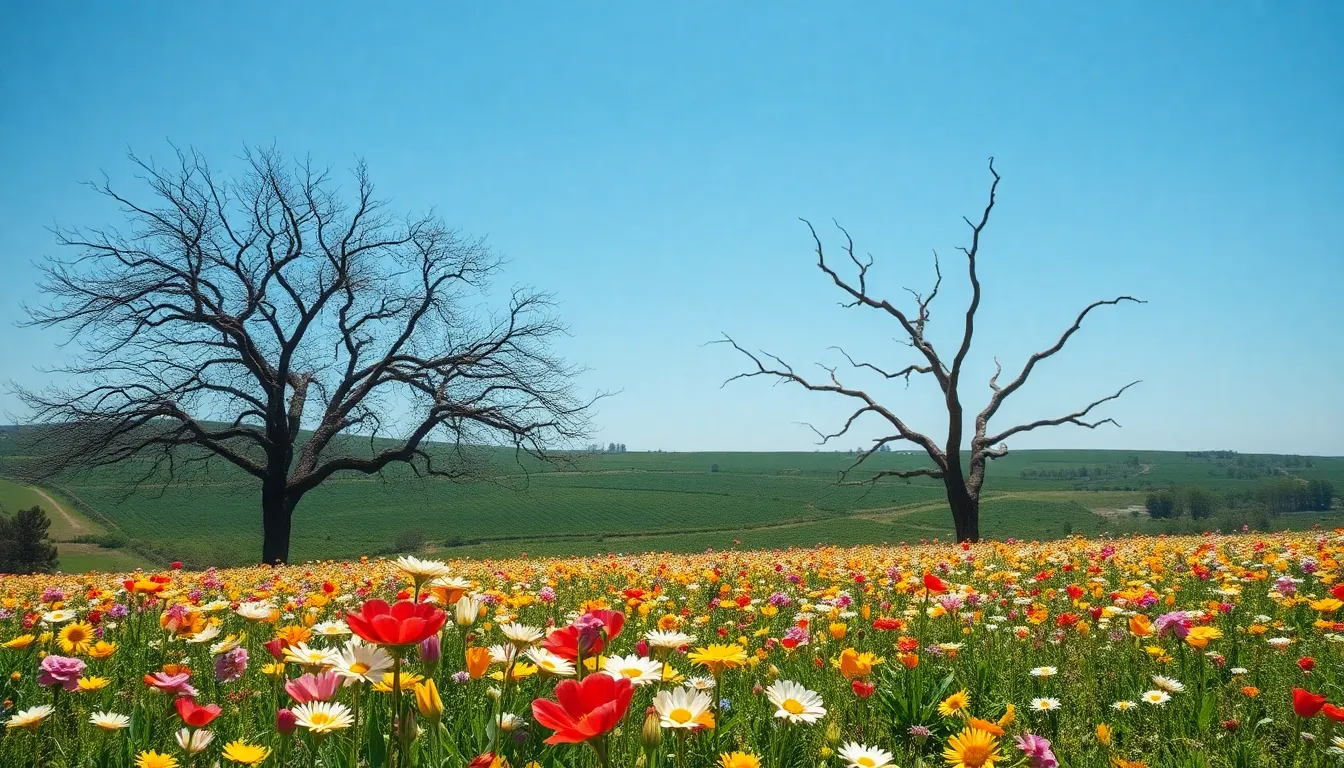Visual motifs are the unsung heroes of storytelling, weaving threads of meaning that elevate narratives from mundane to mesmerizing. They’re like the secret sauce in a gourmet dish—subtle yet essential. From the haunting shadows in a thriller to the vibrant colors in a rom-com, these recurring elements create a visual language that speaks to audiences on a deeper level.
Understanding Visual Motifs
Visual motifs serve as powerful tools in storytelling. They enhance narratives and deepen the audience’s connection to the material.
Definition and Importance
Visual motifs are recurring images or themes that carry specific meanings throughout a story. These elements contribute to the narrative’s emotional depth by reinforcing themes and character arcs. For instance, a filmmaker might use the motif of rain to signify conflict or change. Such consistent imagery not only enriches the viewing experience but also aids comprehension. Audiences recognize and interpret these motifs subconsciously, creating a cohesive understanding of the story’s core messages. The significance of visual motifs lies in their ability to evoke emotions and provoke thought, making them essential for effective storytelling.
Historical Context
Visual motifs have existed for centuries across various artistic forms. Ancient civilizations employed symbols in art and literature to convey complex ideas. In Gothic literature, motifs like darkness and decay often appeared, mirroring characters’ emotional states. The use of recurring imagery evolved further in the 20th century with film and photography, allowing creators to explore new narrative techniques. Iconic works, such as Alfred Hitchcock’s thrillers, employed shadows as motifs to build suspense. Today, visual motifs continue to play a vital role in modern filmmaking, advertising, and design, reflecting cultural trends and viewer expectations.
Types of Visual Motifs

Visual motifs can be categorized into several types, each serving distinct narrative purposes and enhancing storytelling through visual language.
Natural Motifs
Natural motifs often depict elements from the environment, such as water, trees, and animals. These motifs connect characters to their surroundings and symbolize emotional states. For instance, a blooming flower may represent new beginnings, while barren landscapes can signify desolation. Nature imagery frequently reflects themes like growth and decay, allowing viewers to derive deeper meaning from visual cues. In films, seasons often serve as natural motifs, with winter symbolizing hardship and spring representing hope or renewal.
Geometric Motifs
Geometric motifs incorporate shapes, lines, and patterns that create structure within a narrative. Shapes like circles, squares, and triangles may symbolize various themes, such as balance, stability, or conflict. Filmmakers and artists utilize symmetry or asymmetry to guide viewers’ emotional responses. Angular shapes can evoke tension, while curves often convey a sense of harmony and fluidity. These motifs aid in developing visual aesthetics, providing a rhythm that complements the story’s pacing and tone.
Symbolic Motifs
Symbolic motifs carry specific meanings and convey complex themes. Common symbols, such as keys representing freedom or birds denoting liberation, resonate universally with audiences. Filmmakers strategically employ these images to evoke specific emotions, prompt reflections, or signal character transformations. Repetition of these symbols enhances their impact, making them integral to character development and thematic exploration. Iconic examples, like the use of a cross to symbolize sacrifice, illustrate how deeply embedded motifs enrich storytelling layers.
Analyzing Visual Motifs in Art
Visual motifs significantly enhance storytelling in various artistic forms. They provide creators with tools to deepen narratives and guide audience emotions.
Case Studies of Famous Works
Alfred Hitchcock’s films serve as prime examples of visual motifs’ effectiveness. Shadows frequently appear, underscoring themes of mystery and tension. In “Psycho,” the recurring image of the shower evokes vulnerability and fear. Similarly, Vincent van Gogh utilized swirling skies in “Starry Night,” representing emotional turbulence. Works by Frida Kahlo also illustrate visual motifs, as personal symbols recur throughout her paintings, revealing her struggles and identity.
The Role of Color and Composition
Color and composition profoundly impact the effectiveness of visual motifs. Bright colors can evoke joy or love, while dark shades tend to symbolize despair or conflict. Strategic placement of motifs within a composition influences viewer attention and emotional response. For instance, a single red object in a monochromatic scene draws focus, emphasizing meaning. In addition, harmonious color palettes create visual cohesion, reinforcing narrative themes. Compositional techniques, such as balance and symmetry, help guide the audience’s interpretation of motifs and their significance.
Visual Motifs in Modern Media
Visual motifs play a significant role in contemporary storytelling, enhancing narratives across various mediums. They provide consistency, emotional depth, and thematic coherence.
Film and Television
Motifs in film and television guide viewers’ emotional journeys. Shadows often convey tension in thrillers, while bright colors can symbolize romance in comedies. Directors like Alfred Hitchcock expertly use recurring elements to underscore emotional stakes. In “Psycho,” the shower scene exemplifies vulnerability, creating significant emotional resonance. Iconic motifs like a red rose in romantic scenes evoke love, connecting visual representation to audience feelings. Through strategic placements, filmmakers heighten viewer engagement and comprehension, making intricate narratives accessible.
Graphic Novels and Comics
Visual motifs in graphic novels and comics enhance storytelling through images and colors. Bold lines and specific color palettes convey mood and tone, influencing reader perceptions instantly. For instance, dark hues often symbolize conflict, while vibrant colors represent joy. Comic artists employ recurring visual symbols, like lightning bolts, to denote action or transformation. These motifs not only visually unify stories but also deepen character exploration. For example, recurring imagery of a rainstorm can signify internal struggles within a character, enriching the narrative experience.
Visual motifs are essential tools that elevate storytelling across various mediums. By weaving recurring images and themes into narratives, they create layers of meaning that resonate deeply with audiences. These motifs not only enhance emotional engagement but also provide a framework for understanding complex themes and character journeys. As storytelling continues to evolve, the strategic use of visual motifs will remain a powerful technique for artists and creators, ensuring that their messages are conveyed effectively and memorably. Embracing these elements can transform a simple story into a rich tapestry of visual language that captivates and inspires.





